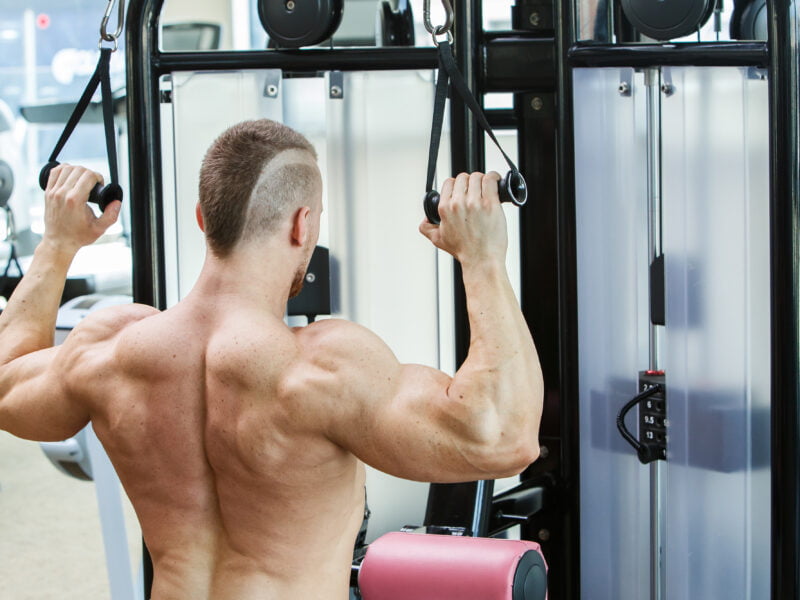It doesn’t tell you the whole story of your weight management and fitness journey, it just tells you your current weight. And, losing weight isn’t the only metric your fitness is measured in. Your muscle gain and fat loss, are other things that also indicate that your hard work is paying off.
When you’re aiming to gain muscle and lose fat simultaneously, your body is undergoing a transformation that isn’t always reflected in mere numbers. So, how do you know if you’re making progress?
Let’s take a look at the science behind muscle gain and fat loss, and discover the 10 signs of gaining muscle and losing fat.
Science Behind Muscle Gain & Fat Loss
On the other hand, fat loss is primarily about creating a calorie deficit, meaning you burn more calories than you consume. This leads to the body using stored fat for energy. The interplay between these two processes determines changes in body composition.
10 Signs That You Are Gaining Muscle & Losing Fat

1. Visible Muscle Definition
As you shed fat, the muscles underneath become more visible. This results in better muscle definition, particularly in areas like the arms, legs, and abdomen. If you notice your muscles becoming more pronounced, it’s a good sign you’re gaining muscle and losing fat.
2. Clothes Fit Differently
A changing body composition often means your clothes fit differently. You might find your pants are looser around the waist but tighter around the thighs and glutes. This is a sign that you’re losing fat in the waist area while gaining muscle in your legs and glutes.
3. Increased Strength
One of the most definitive signs of muscle gain is an increase in strength. If you find yourself lifting heavier weights or doing more repetitions with the same weight, it’s a clear indicator that your muscles are growing. According to the American Council on Exercise, noticeable strength gains can occur within eight weeks of regular resistance training.
In case your strength isn’t increasing you can try the muscle-building routine followed by wrestlers to see results faster.
4. Enhanced Endurance
As your fitness improves, so does your endurance. Whether it’s running longer distances, cycling for extended periods, or completing high-intensity workouts, increased endurance is a sign of improved cardiovascular health and muscular efficiency. This means you’re likely losing fat and gaining muscle, which supports prolonged physical activity.
Both cardio and weight lifting can help in improved endurance, but the amount of calories burned is different.
5. Reduced Body Measurements
Even if the scale isn’t showing much change, taking regular measurements of your waist, hips, chest, and limbs can reveal significant changes. A smaller waist circumference typically indicates fat loss, while increased measurements in other areas can signify muscle gain.
6. Stable or Increased Weight
It might seem counterintuitive, but gaining muscle and losing fat can result in stable or even increased body weight. This is because muscle tissue is denser than fat tissue. So, while you may be losing fat, the muscle you’re gaining can offset weight loss, keeping the scale relatively stable.
7. Improved Metabolic Rate
Muscle tissue burns more calories at rest compared to fat tissue. Therefore, as you gain muscle, your basal metabolic rate (BMR) increases, meaning you burn more calories throughout the day, even when not exercising.
8. Better Posture
Muscle gain, particularly in the core and back muscles, can significantly improve your posture. If you notice you’re standing taller and your back feels stronger, it’s a sign that your muscles are developing properly.
9. Faster Recovery Times
As your body adapts to regular exercise, recovery times shorten. This means your muscles repair and grow stronger more quickly, which is a positive sign of muscle gain and overall fitness improvement. If you’re experiencing less soreness and quicker bounce-back between workouts, you’re on the right track.
10. Positive Changes in Mood and Energy Levels
Regular exercise and improved body composition have a profound impact on mental health. Many people report feeling happier, more energetic, and less stressed. These mood improvements are often accompanied by better sleep quality, which further supports muscle growth and fat loss. You can also try out some somatic exercises that help in improving mental health.
What Happens to Body Composition When You Gain Muscle & Lose Fat at the Same Time?

Simultaneously gaining muscle and losing fat leads to a favorable shift in body composition. This process is often termed “body recomposition.” When you undergo body recomposition, you might not see a dramatic change in your overall weight, but you will notice a significant transformation in how your body looks and feels.
A study from the American Journal of Clinical Nutrition found that individuals who combined resistance training with a high-protein diet experienced significant fat loss while gaining muscle mass. This highlights the importance of both exercise and nutrition in achieving optimal body composition.
Body recomposition can be achieved by improving your behavior towards workouts and diets and monitoring your growth.
Role of Muscle & Fat in Body Composition
However, excess body fat, particularly visceral fat (the fat around your organs), is associated with numerous health risks, including heart disease, diabetes, and metabolic syndrome. Reducing excess fat while gaining muscle can improve health markers, enhance physical performance, and promote longevity.
Parting Thought
So, next time the scale doesn’t move, don’t get disheartened. Pay attention to these signs and trust the process. Your body is constantly adapting and improving. Celebrate the small victories and stay consistent.


![Does Using Crutches Build Muscle: Complete Guide [Updated]](https://supeshealth.com/wp-content/uploads/2024/03/full-shot-smiley-man-training-800x600.jpg)


